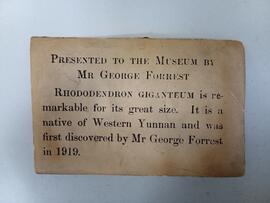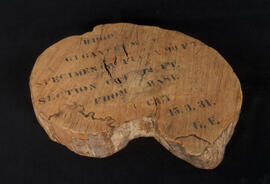RBGE Museum label used in the display of George Forrest's Rhododendron giganteum / Rhododendron protistum stating: 'Presented to the Museum by Mr George Forrest. Rhododendron Giganteum is remarkable for its great size. It is a native of Western Yunnan and was first discovered by Mr George Forrest in 1919.'
Royal Botanic Garden Edinburgh (Creator)Museum label that was used on display with Forrest's Rhododendron giganteum / Rhododendron protistum.
Label states 'Rhododendron Giganteum, Forrest. Cross section of stem of a tree fully 90 feet high. This section was taken 12 feet from the base.'
This is a small series of items relating to the section of Rhododendron giganteum - now named Rhododendron protistum found and collected by George Forrest and his collectors in Yunnan, China on the 15th March 1931. The series consists of the specimen itself, and two of its museum labels.
For more information: (right click, open link in new tab) https://stories.rbge.org.uk/archives/14186
Section of Rhododendron protistum [Rhododendron giganteum] felled by George Forrest's collectors in March 1931.
Forrest, Georgeone map used in Forrest's article describing the geography and people of the Upper Salween during his visit there with Consul George Litton in late 1905. The article was published by the Royal Geographical Society in 1908 with this accompanying map, and again by the National Geographical Society in 1910.
Royal Geographical SocietyDescription of valley from Hsia Kuan [Xiaguan] to Shang Kuan [Shangguan] and city of Tali [Dali]. Hsia Kuan is a customs station and the most important business centre in Western Yunnan, with population of over 12,000, all of whom are engaged in trade; important centre of opium production, with some trade in Szechuanese, Cantonese and foreign goods; Litton advocates establishment of a Chinese agency at Hsia Kuan by some foreign firm. Tali plain narrow and fertile, densely populated mainly by Minchia people, very mixed with Chinese; description of their dress and customs, temple of the Goddess of Mercy and legend of the monster Yao Kwei. Principal officials and administration of city of Tali, its main buildings, walls towers and streets, insanitary conditions and prevalence of disease; population c.5,000; much of city in ruins following ‘the rebellion’ [Mohammedan [Muslim] rebellion]; rough sketch of earthen city wall with brick facing. Details of goods for sale include gold, some from Tibet but mainly obtained from the Yangtse.
Forrest, George

